|
Lockheed-Martin F-35C Lightning II
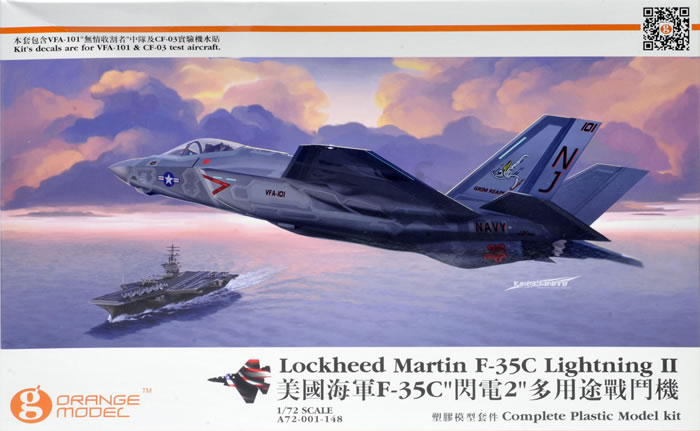
Orange Model, 1/72 scale
S u m m a r y : |
Catalogue Number: |
Orange Model Kit No. A72-001-148 - Lockheed-Martin F-35C Lightning II |
Scale: |
1/72 |
Contents & Media |
98 grey and four tinted clear plastic parts, three PE frets, copper wire and metal rod, plus decals for two options. |
Price: |
I could only find one online stockist aside from e-Bay sellers, and this was Hobby Easy of Hong Kong:
|
Review Type: |
First Look |
Advantages: |
Very good quality, detailed mouldings, excellent ejection seat, includes aircraft tug and tie-down chains. |
Disadvantages: |
The main painting guide is essentially worthless, but is compensated for by a very comprehensive mask set available separately for 32% of the kit’s price. |
Conclusions: |
This is a generally superb first effort at an injected kit by Orange Model. It is a very nicely engineered kit produced to high standards. It is also packaged well, and has clear assembly instructions. The levels of detail are very good, with the best non-resin ejection seat I can recall in this scale.
It is not the only F-35 kit to feature raised detail for the RAM appliqué, but some will condemn the kit for its prominence. I am more puzzled by finding it on areas of the kit I have not observed in online images of the real plane. I am unsure if it should be the same colour as the main airframe, or contrast with it, for the markings options provided. If the latter is the case, then having decals to represent it would be preferable to masking and painting the raised detail.
Some will welcome the well-detailed tractor and PE tie-down chains, I am neutral about such things, and would rarely bother with using them.
I would happily trade the tractor and chains for some RAM appliqué decals and, even more importantly, an adequate painting guide. The one provided with the kit is essentially worthless for anything but decal placement. I guess this can be overcome by research, but it should not be necessary to do so for a painting scheme as potentially complex as the F-35C’s. Most will I suspect opt to buy the almost mandatory masking set sold separately for 32% of the kit’s price.
If I were to apply any kind of litmus test to this kit, it would be this; prior to the review, I had little to no interest in the F-35 as a subject, and this has not changed much. However, I now find myself wanting to build this Orange Model kit! The way they have captured the aircraft’s shape and the engineered the kit makes it just very tempting to build. I cannot think of a better recommendation than that! |
Reviewed by Mark Davies

Airfix's 1/72 Hurricane Mk.I Fabric Wing is available online from Squadron.com
Background
The Lockheed Martin F-35 Lightning II is a family of single-seat, single-engine, all weather, stealth multirole fighters undergoing testing and final development. The fifth generation combat aircraft is designed to perform ground attack, aerial reconnaissance, and air defence missions. The F-35 has three main models: the F-35A conventional takeoff and landing (CTOL) variant, the F-35B short take-off and vertical-landing (STOVL) variant, and the F-35C carrier-based Catapult Assisted Take-Off Barrier Arrested Recovery (CATOBAR) variant.
Compared to the F-35A, the F-35C carrier variant features larger wings with foldable wingtip sections, larger wing and tail control surfaces for improved low-speed control, stronger landing gear for the stresses of carrier arrested landings, a twin-wheel nose gear, and a stronger tail-hook for use with carrier arrestor cables. The larger wing area allows for decreased landing speed while increasing both range and payload.
The United States Navy intends to buy 480 F-35Cs to replace the F/A-18A, B, C, and D Hornets and complement the Super Hornet fleet. On 27 June 2007, the F-35C completed its Air System Critical Design Review (CDR), allowing the production of the first two functional prototypes. The C variant was expected to be available beginning in 2014. The first F-35C was rolled out on 29 July 2009. The United States Marine Corps will also purchase 80 F-35Cs, enough for five squadrons, for use with navy carrier air wings in a joint service agreement signed on 14 March 2011. A recent 2014 document stated that the USMC will also have 4 squadrons of F-35Cs with 10 aircraft per squadron for the Marine Corps' contribution to U.S. Navy carrier air wings.
Source: Wikepedia
Caveat
I feel that I have a reasonable knowledge of most aircraft types, but I must confess to having only a passing interest in the latest types such as the F-35 Lightning II. This is despite the fact that there is a mountain of information available on the type’s development so far.
My lack of familiarity with the subject means I have struggled to relate Internet images to the kit contents, as despite being aware of the F-35C’s key airframe features, it has proved difficult to me to know whether an image I am viewing is of a production model or a development prototype. I must state in advance that I am not qualified to judge the accuracy of the review kit’s features in any depth, and will have to leave that to others with more passion and knowledge of the type.
Previous 1/72 scale F-35 Kits
There are several Lightning II kits in The One True Scale, and its X-35 developmental prototype, as the table below indicates. There are only two F-35C variants so far however. These are the Orange Model kit reviewed here and an offering from Kitty Hawk. Regrettably, I am not in a position to comment on the merits of each kit.
Kit Brand |
F-35A |
F-35B |
F-35C |
X-35 |
Remarks |
Academy |
|
|
|
|
|
Cyberhobby |
|
|
|
|
|
Fujimi |
|
|
|
|
|
Hasegawa |
|
|
|
|
|
Italeri |
|
|
|
|
|
Kitty Hawk |
|
|
|
|
|
Orange Hobby |
|
|
|
|
|
Revell |
|
|
|
|
Re-box of Italeri kit |
Tamiya |
|
|
|
|
Re-box of Italeri kits |
I am not familiar with Orange Hobby, which I think has previously produced PE and resin accessories, this review kit being their first injected styrene product.
Contents
The kit comes in a top-opening box made from good quality glossy card. Written instructions are in Chinese and English. Lacking a parts map, the instructions are well produced, with clear and well-drawn diagrammatic assembly stages. The detail colour call-outs use generic colour names. The main sprues come enclosed in several plastic bags.
Three small PE frets, some copper wire, and small metal rod are in another bag; with a tinted clear canopy further protected in its own bag.
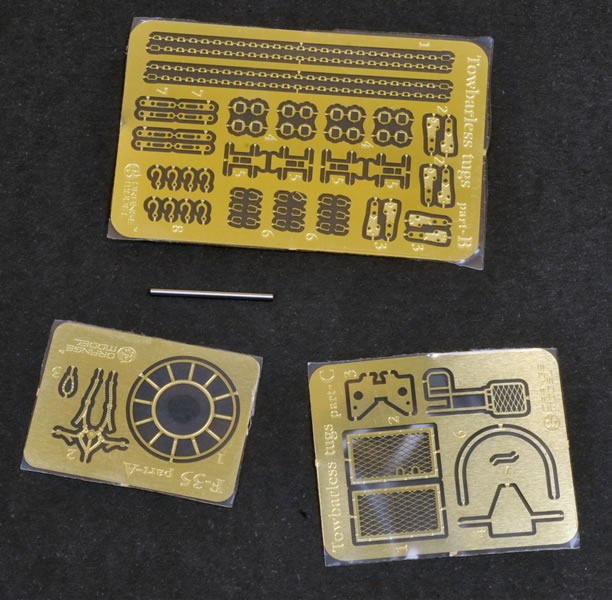
The two decal sheets have their own clear film protection.
The quality of the kit’s styrene components appears to be excellent, with crisp moulding, no flash and fine sprue gates. The tinted canopy is suitably clear, free from flow marks, and acceptably thin. The PE frets appear to be very good as well. The decals are well registered, glossy and quite acceptable overall, but not quite as finely printed, as say, top brands like Cartograf.
Overall, the impression I gained on opening the box was very good, especially so for a first effort at an injected kit.
The Kit
In considering how to approach this first look, I have chosen to deal first with what for me was the “elephant in the room”.
Despite some very fine moulding of detail parts, the RAM appliqué is represented by rather prominent raised surfaces. This is not as severe as it may appear in the accompanying images, but is clearly over-pronounced for scale effect. This will not matter a great deal for some, as in 1/72 just about all surface detail is over scale in truth (as it is with many other scales too).
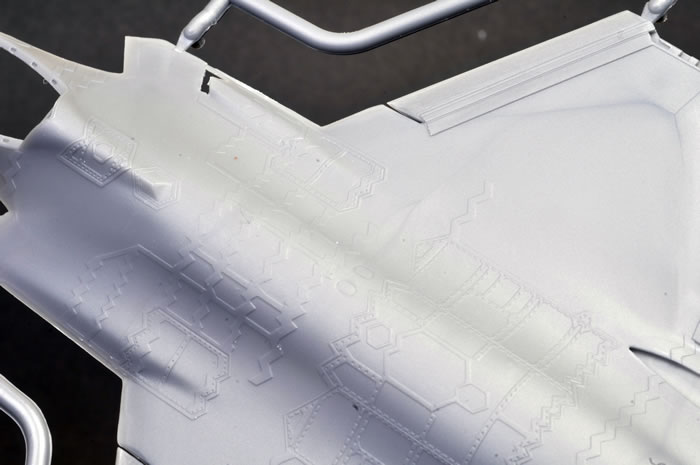
The raised nature of this detail will I think be lessened once painted. However, herein lays the problem, as it will be a pain to mask all of the densely clustered and fiddley little angles. The provision of decals to portray the RAM appliqué would make life far easier, and lead to a more effective result I feel. (I believe that Hasegawa adopted this approach for their kit, although they also used recessed lines to outline the affected areas, which seems a bit unrealistic to me.)
Orange Model does not mention any need to paint the RAM appliqué a different colour from the main airframe colour, despite this often appearing in a lighter grey. In fairness, and harking back to my introductory caveat, I have seen F-35 images where the airframe is all one colour such as the link to this F-35C image here, and others where it contrasts with the main airframe colour as evidenced in the F-35C image linked to here. The extent of the RAM appliqué also seems to vary, with Orange Model’s F-35C having more in the dorsal area of the fuselage than some photos of as the image linked here shows. Frankly, I cannot say what is correct, but still think decals would ease dealing with the contrasting option either with or without moulded detail.
Having at least discussed the elephant in the room, although having failed to get it to leave, we can now return to normal review service by looking at the kit’s cockpit...
Orange model has provide the best-detailed non-resin ejection seat I can recall seeing in a 1/72 scale kit. This consists of four styrene parts and a nice PE harness plus PE firing handle.
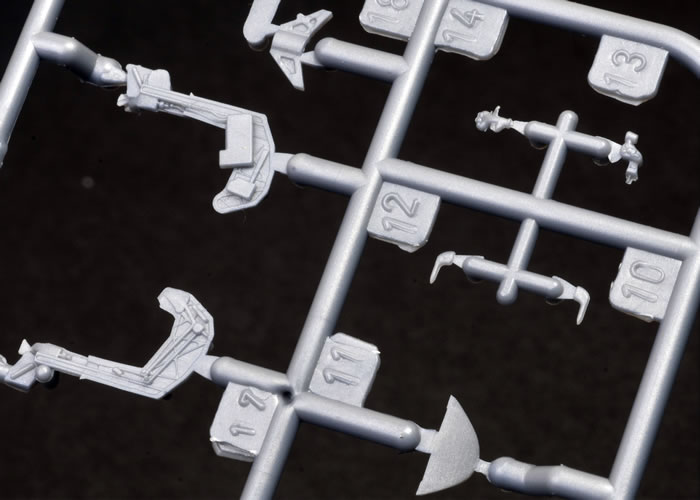
This sits in a quite well detailed cockpit tub, whilst the instrument panel relies on a decal for detail, which seems acceptable for an “all-glass” cockpit.
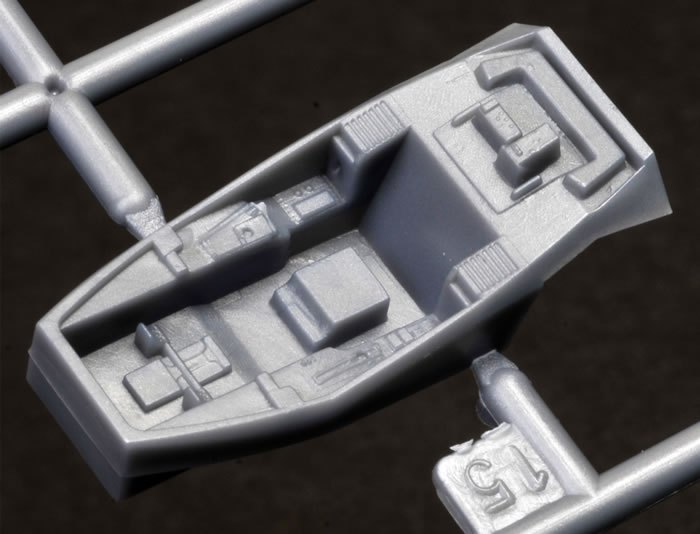
The fuselage halves are split horizontally. Aside from installing the cockpit within these, there two nicely detailed weapon bays and three wheel-wells to fit, some elaborately curved air intake trunking, and the engine afterburner casing (the exhaust nozzle is fitted later). The afterburner is blanked off with a turbine face and has a PE flame holder to fit.
The undercarriage itself is nicely detailed, as are its doors.
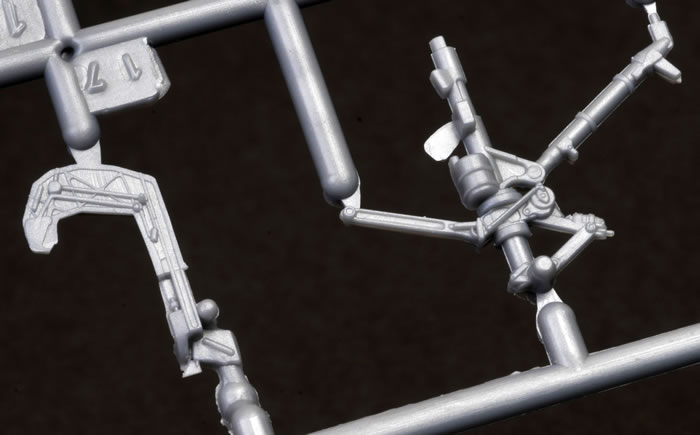
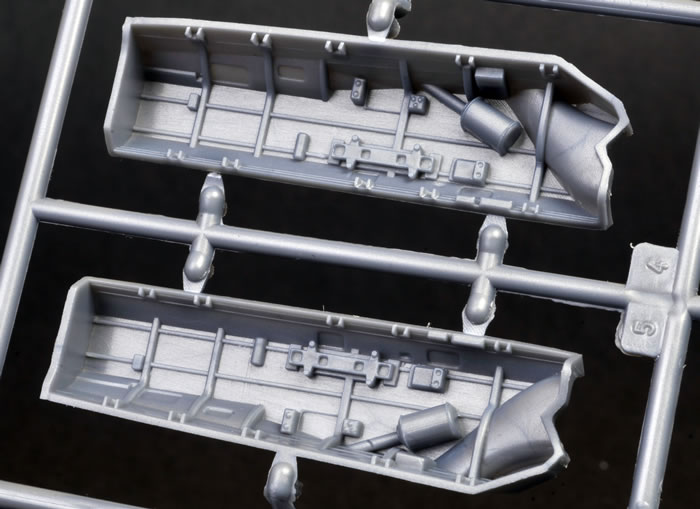
The other doors, which include prominent hinges, are for the weapons bays, as are two AIM-120 missiles for stowage within them. There are additional wing pylons, two AIM-9X missiles, plus a GAU-22/A gun-pod as well. Obviously, there will be missions where stealth is not a priority, in which case external stores can be carried. It would have been nice if a greater range of stores were provided. However, Orange Model also offers some Joint Strike Missiles as separate accessories, which can be viewed by clicking here.
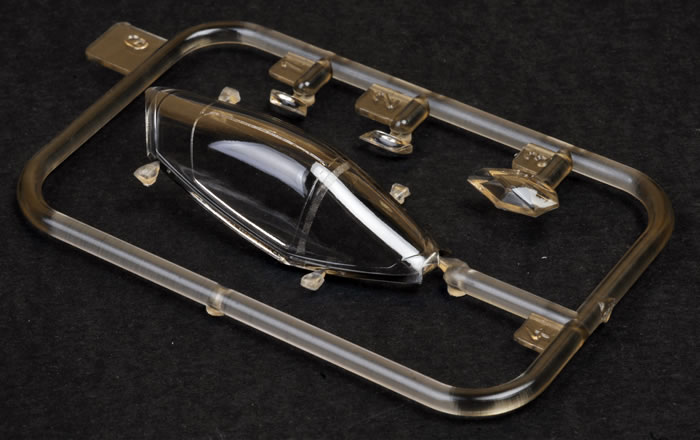
There is not much related to the airframe that remains to mention. There are of course the F-35C’s folding wingtips and the horizontal stabilators to fit; and like the canopy, these can be posed in different positions. Overall, I should think that this should be a quite straightforward kit to build.
The kit also includes a well-detailed carrier-borne aircraft tug that accounts for one of the PE frets, and the metal axle, whilst the largest of the three PE frets provides for tie-down chains and their tensioning hooks. Some will welcome the addition of these very nice diorama accessories, whereas I would trade them for the inclusion of RAM appliqué decals if given the choice.
Colours & Markings
Two schemes are provided, for VFA-101 “Grim Reapers” and CF-03/05 Test Aircraft. The colours & markings guide is quite clear on decal placement, but I feel it is very vague on colours. It only specifies one colour, described as “Dark Grey”, despite the box-art and colour profiles on the box sides showing two distinct shades used throughout the airframe. I can only describe the guide as being inadequate.
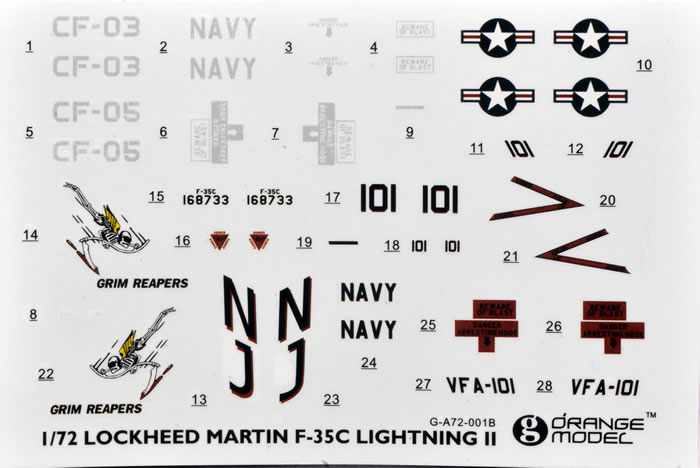
Right at the end of writing this review, I checked Orange Model’s website, and saw that they offer a masking set for the kit as an accessory item. I would like to say all is forgiven, and I suppose it almost is. The masking set appears to be very comprehensive. It costs 32% of the kit’s price, which is probably why it is not included with it.
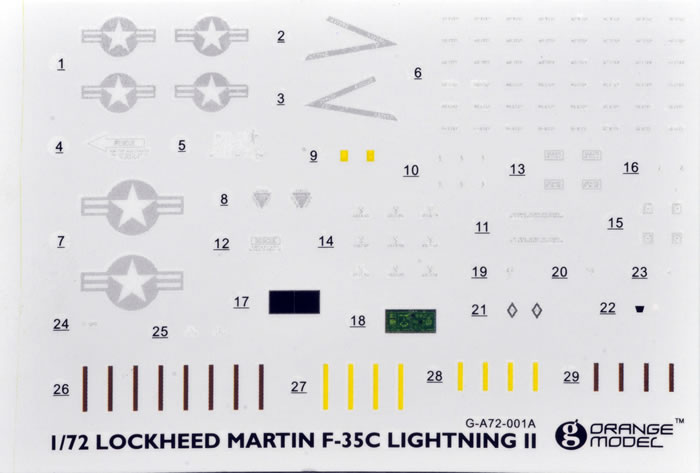
With the availability of a masking set I would advocate sanding down the raised RAM appliqué detail to some extent, or even entirely, for a more authentic scale finish.
This is a generally superb first effort at an injected kit by Orange Model. It is a very nicely engineered kit produced to high standards. It is also packaged well, and has clear assembly instructions. The levels of detail are very good, with the best non-resin ejection seat I can recall in this scale.
It is not the only F-35 kit to feature raised detail for the RAM appliqué, but some will condemn the kit for its prominence. I am more puzzled by finding it on areas of the kit I have not observed in online images of the real plane. I am unsure if it should be the same colour as the main airframe, or contrast with it, for the markings options provided. If the latter were the case, then having decals to represent it would be preferable to masking and painting the raised detail.
Some will welcome the well-detailed tractor and PE tie-down chains, I am neutral about such things, and would rarely bother with using them.
I would happily trade the tractor and chains for some RAM appliqué decals and, even more importantly, an adequate painting guide. The one provided with the kit is essentially worthless for anything but decal placement. I guess this can be overcome by research, but it should not be necessary to do so for a painting scheme as potentially complex as the F-35C’s. Most will I suspect opt to buy the almost mandatory masking set sold separately for 32% of the kit’s price.
If I were to apply any kind of litmus test to this kit, it would be this; prior to the review, I had little to no interest in the F-35 as a subject, and this has not changed much. However, I now find myself wanting to build this Orange Model kit! The way they have captured the aircraft’s shape and the engineered the kit makes it just very tempting to build. I cannot think of a better recommendation than that!
Thanks to Orange Model for this review sample
Review Text Copyright © 2015 by Mark Davies
Kit Contents Images Copyright © 2015 by Brett Green
Page Created 22 February, 2015
Last updated
22 February, 2015
Back to HyperScale Main Page
Back to Reviews Page

|
